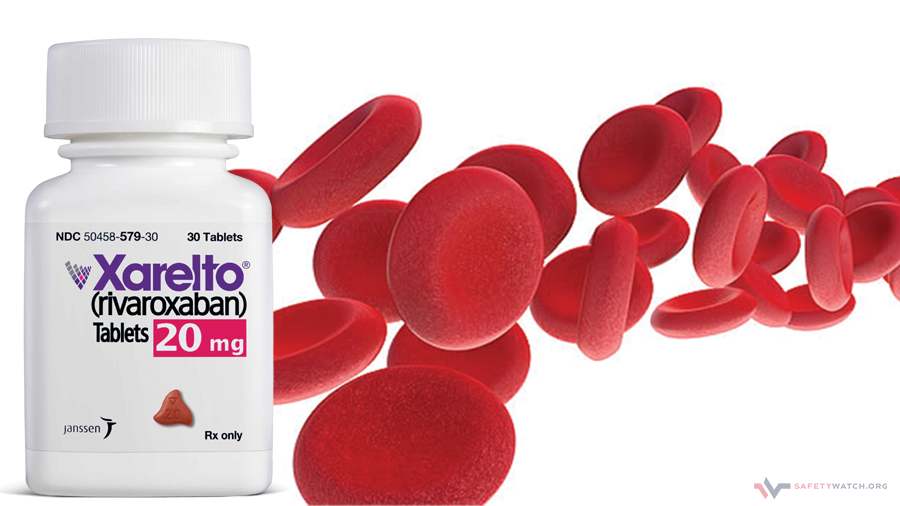Patients are prescribed to pin their hopes on a pill after suffering from atrial fibrillation and blood clots, taking once daily the blood thinner that saved them from even routine blood monitoring: Xarelto®.
But what they may not know is the anticoagulant drug they are prescribed to take may cause severe injuries and even fatal damages in their bodies, as thousands of previous users of the anti-clotting drug stated in their claims against the drug makers Bayer AG and Johnson & Johnson.
Since 2011, the year Xarelto® (rivaroxaban) was approved by the Food and Drug Administration for the U.S market, more than 20,000 lawsuits have been filed on the claims that the risks of internal bleeding and stroke caused by the medicine were concealed by the manufacturers for marketing purposes. The lawsuits are overseen in Multidistrict Litigation Courts, or MDLs, which centralize the cases coming from all around the country to make the trials more efficient. These particular cases in federal court are controlled by the presiding U.S. District Court Judge Eldon E. Fallon.
In the meantime, the anti-clotting drug have generated billions of dollars for Bayer and Johnson & Johnson – including a $3.7 billion revenue in 2014 alone.
Several federal bellwether cases have been held so far, all resulting in the ruling that cleared Bayer and Johnson & Johnson of liability over Xarelto’s risks. However, the first Xarelto trial in Philadelphia was held in November 2017, resulting in a plaintiff’s verdict with a $27.8 million award for Lynn Hartman of Indiana. The verdict was later reversed by the judge due to a technicality on a procedural issue.
Questionable FDA regulations
The FDA approval process on new products is continuing to raise questions as the agency does not conduct an independent study of the products hitting the market. Such studies and tests are performed by the manufacturer company that seeks the approval – a conclusion that is not guaranteed if any flaw is discovered by the company during the study, which can preclude the medical device or the drug from being approved. In other saying, the testing and reporting period is left under the initiative of the manufacturer companies.
According to attorney Christopher K. Johnston from the Johnston Law Group, the FDA approval process has another problematic procedure that eases the approval of a new product that is similar or equivalent to another one that has already been on the market and approved by the FDA.
“Once there is a product that is on the market, the other way that you can get the product approved is through the 510(k) process,” Johnston says. “And that process is very short, it doesn’t require you to do hardly any studies.”
The manufacturer company has to assert that the new product to be introduced is substantially equivalent to the one that has already been on the market. After the assertation, the FDA is not required to conduct any investigation or research independent from what is provided by the company.
If the basis product that is already on the market is recalled by the FDA because it is defective, it will not affect the second similar product that had received the approval through the 510(k) process.
Before receiving approval, drugs are required to be clinically tested. The clinical trial for Xarelto® featured a medical device that was recalled in July 2016. ROCKET-AF, the trial, provided the primary information supporting the FDA’s approval of Xarelto®; however, it has been questioned because of the faulty medical device, Alere INRatio.
The conclusion of the test suggested that Xarelto® was safe enough compared to other blood thinners. In October 2016, the FDA announced on its website that the analyses found no effect of the faulty monitoring device on the clinical trial: “The FDA concludes that Xarelto® is a safe and effective alternative to warfarin in patients with atrial fibrillation.”
A recent Netflix documentary, The Bleeding Edge, intends to shed light on these questionable U.S. regulations during the approval process of controversial medical devices that cause severe damages on users. The documentary has received a lot of feedback from consumers across the nation.
In an interview with the MD+DI, the documentary’s producer Amy Ziering stated that the approval based on another device that has been recalled is “out of satire.” Ziering also added that they had many “fairly shocking” reports that did not end up in the film.
The way that the FDA is set up has been highly questioned with the recent deregulation actions and links between its employees and big pharmaceutical companies. Since January 2017, the Agency has withdrawn the most rulemakings of any HHS agency.
Another flaw on the process could be the number of injury reports represented. Because the FDA only tracks voluntary reports, the number of injured people by Xarelto® could be much higher. In addition, there is no requirement that doctors notify the manufacturer about an adverse incident when they come across that problem.
“This is absolutely misrepresentative of the number of people that are being affected by this product,” Johnston says.
In May, an antidote for Xarelto’s uncontrolled bleeding effect was approved by the FDA. AndrexXa, the antidote, is set to be on the market in 2019.
When asked about how the recent announcement of the reversal agent will affect the trials, Johnston underlines that the manufacturers have been hiding information about the development of this antidote because publicizing it would imply that they already knew there was something wrong for not having a reversal agent.
In the bellwether cases, the defendants were asked whether or not they had the reversal agent for Xarelto’s adverse effects.
“It was denied, denied, denied, and all of a sudden it was publicized,” says Mr. Johnston. “We shouldn’t have had to find out that way.”
Xarelto’s selling strategy and hidden information
Xarelto® lawsuits have brought out another debate that the manufacturer representatives, the defendant side, claim that such unjust suffering filings were based on solicitation and false advertising by attorneys on profit purposes.
“They would grab on to anything they can to get away from what is really going on and distract people so that it doesn’t harm their product,” says Dianna Albini, also from the Johnston Law Group, who is a retired judge from California. “I used to refer to it as grabbing a handful of mud, throwing up against the wall and seeing what sticks.”
One of the main points of the filing of Xarelto® lawsuits is that the drug was rushed through the process because it cost a lot of money to Janssen (parent of J&J) and Bayer. This links to the advertisement money and selling strategies used by the companies over the time Xarelto® has been on the American market.
Prominently, one of the advantages of using Xarelto® blood thinner is that it does not require patients to have routine blood tests, and only one pill a day is sufficient. However, for previous blood thinners such as coumadin, the extra work that goes into blood tests and other medical procedures is required on therapy.
“You register for bloodwork, bloodwork comes back, you have to review it, you have to document it, you have to then call the patient,” says Albini. “With Xarelto®, all of that is eliminated. And if they have hundreds of patients that are having this done, that’s a significant traffic of time.”
Another big controversy within the lawsuits is the bleeding events that is caused by the drug. Thousands of plaintiffs have stated that they suffered severe bleeding or strokes as a result of taking Xarelto®, in addition to the claims that Johnson & Johnson and Bayer have hidden crucial information about these adverse events from the public. After the release, the drug’s label has included several warnings, including two black box warnings.
Albini says they have clients who have required blood transfusion, basically twice the amount of the blood one has in their system. “Those things were not disclosed in the original labels,” she says.
Legally, it is the manufacturers’ duty to warn consumers of any possible consequence or risk of using their product; however, many U.S. courts have applied the learned intermediary rule in cases associated with pharmaceutical and medical device tort defenses.
A 1966 decision by the Eighth Circuit has introduced the term “learned intermediary,” a doctrine which is then adopted by a majority of states, reasoning a doctor is an intermediary between the user of a prescription drug and the manufacturer company.
According to American Bar Association, the doctrine allows drug manufacturers “to discharge their duty to warn consumers about their products by informing the learned intermediary, commonly the prescribing physician.”
Under the rule, it is sufficient for manufacturers to inform doctors about the risks through their labels, thus any knowledge that is imparted to the doctor automatically attaches to the patient.
Under circumstances of dual medication or triple therapy when taking Xarelto®, the chance of bleeding is 80-fold, Albini says. “What doctors have been saying is ‘Under the information I have, maybe there is 5 percent or 2 percent chance that there is going to be a bleeding event’”
Some doctors think the benefits of Xarelto® outweigh the risks, but if the doctors were told it is 80 percent, then they would not think that the risk was worth it, according to her.
Making people not want to pursue their rights
Apart from the regulatory benefits that the big pharmaceutical companies may receive, several amicus curiae briefs have been provided by the Product Liability Advisory Committee, in support of the manufacturers in different mass torts.
Such claims of solicitation and false advertising about the risks came from various pro-tort reform personalities and public health experts, including Public Health Analyst James M. Beck, who is the chair of case selection committee of the PLAC. The PLAC, which has Bayer and Johnson & Johnson among its corporate members, operates as a non-profit.
According to Albini, their annual revenue could be anywhere from a $100 million to $500 million a year that they are being paid by the manufacturer. Given that, manufacturers, insurance companies and big businesses spend hundreds of millions of dollars in advertisement – advertising the safety of the product, the tort reform, promoting the claims that the lawsuits are being filed by “ambulance chasers.”
“The reason they spend so much money on advertising is to make people not want to pursue their rights,” says Albini. “It’s almost like, the person who is injured is apologizing for proceeding to pursue their rights.
The vast majority of Xarelto® victims is the older population, and they need blood thinners because they suffer anomalies mostly related to aging. Albini adds that companies are targeting a population that comes from a generation who does not question doctors.
“Its generational, taking advantage of consumers that they know are probably not going to mention it, and that’s wrong,” she says.
Written by:

Emre Ertugrul
Emre Ertugrul is a reporter for Safetywatch.org, covering controversial drugs and medical devices, reporting on health policy and the FDA. He studied journalism with concentration in investigative reporting at Boston University. Previous experience with the New England Center for Investigative Reporting include tax issues, racial profiling and criminal justice. He also worked as an international news intern at Milliyet Newspaper and is currently one of the editors for Gazet.com.

Get a Free Xarelto® Case Review
If you are one of the thousands of people who have experienced bleeding after taking Xarelto®, you may be eligible to receive a compensation for your injuries.

